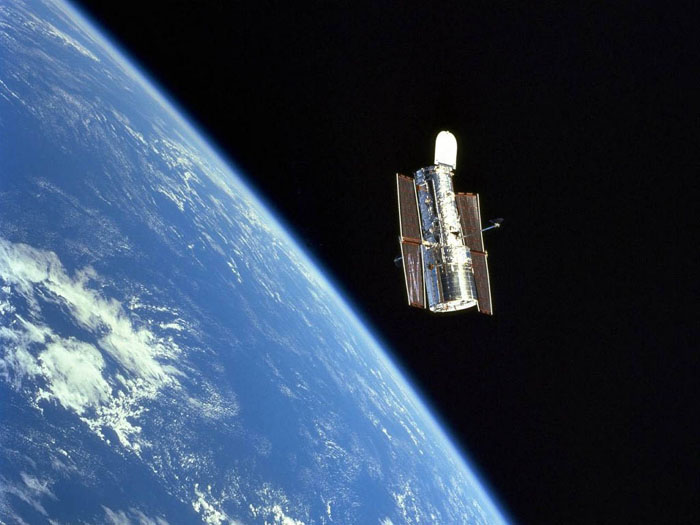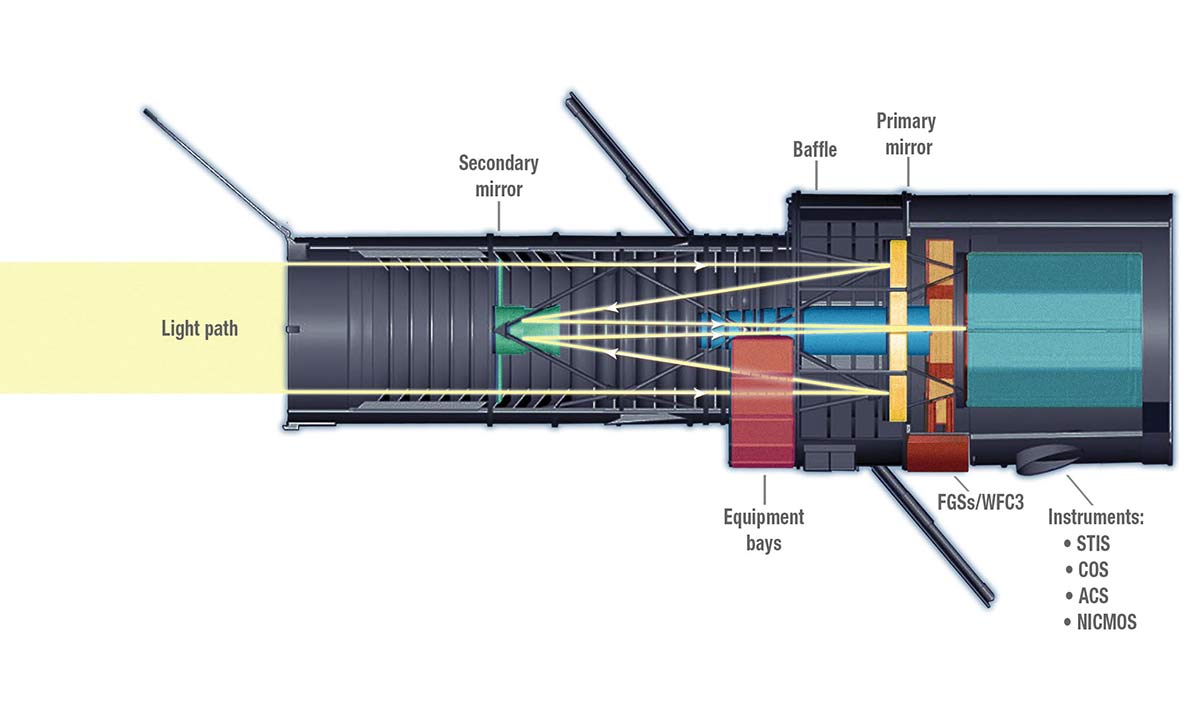Hubble Space Telescope

Hubble Space Telescope in orbit.

This is a cutaway diagram of the Hubble Space Telescope, with components labeled. The forward shell houses the telescope's optical assembly. In the middle of the telescope are the reaction wheels and the bays that house the observatory's control electronics. The aft shroud houses the scientific instruments, gyroscopes, and star trackers. The instruments are located in containers that make them easy to remove and replace.

This diagram shows the path that light from the universe travels when it enters Hubble. Hubble's 1,825-pound, 7.8-foot (2.4-meter) diameter primary mirror collects light from its astronomical target and reflects it to a 12-inch (0.3-meter) diameter secondary mirror located in the optical tube. This secondary mirror then reflects the light through a hole in the primary mirror to form an image at the telescope's focal plane. There it is intercepted by pick-off mirrors that pass it into the scientific instruments. Hubble's mirrors are made of ultra-low expansion glass kept at a "room temperature" of about 70°F (21°C) to avoid warping. The reflecting surfaces are coated with a 3/1,000,000-inch layer of pure aluminum and protected by a 1/1,000,000-inch layer of magnesium fluoride that also makes the mirror more reflective to ultraviolet light. Credit: NASA's Goddard Space Flight Center, ESA.
The Hubble Space Telescope is an orbiting observatory, built and operated
jointly by NASA and the European
Space Agency, which is equipped with a main mirror 2.4 meters (94.5
inches) in diameter. It is named after American astronomer Edwin Hubble.
The Hubble Space Telescope (HST) is the visible/ultraviolet/near-infrared
element of the Great Observatories program. With its high resolution, the HST has revolutionized many aspects
of astronomy and cosmology. Science operations are conducted from the Space
Telescope Science Institute (STScI) in Baltimore, Maryland.
| HST deployment date | Apr 25, 1990 |
| shuttle mission | STS-31 (Discovery) |
| orbit | 590 × 596 km × 28.5° |
| dimensions | 13.3 × 4.3 m |
| mass | 10,863 kg |
History
The idea for a telescope in space was discussed as early as 1923 by the German rocket pioneer Hermann Oberth. In 1969, astrophysicist Lyman Spitzer gathered the support of other astronomers for a 'large orbital telescope'. In 1969, the National Academy of Sciences gave its approval for the Large Space Telescope (LST) project, and hearings and feasibility studies continued. The Hubble Space Telescope was authorized by the US Congress in 1977, and designed and built in the 1970s and 1980s. Deployed on 25 April 1990, from the Space Shuttle Discovery, it orbits approximately 600 kilometers (375 miles) above the Earth's surface.
Hubble is the first and, so far, only telescope to have been serviced in orbit by astronauts. There have been a total of five servicing missions between 1993 and 2009.
Servicing Mission 1 (SM1)
2 December 1993: (STS-61) Launch of Shuttle Endeavour· COSTAR corrective optics installed, replacing HSP
· WFPC2 replaced WFPC
Servicing Mission 2 (SM2)
11 February 1997: (STS-82) Launch of Shuttle Discovery· STIS replaced FOS
· NICMOS replaced GHRS
Servicing Mission 3A (SM3A)
19 December 1999: (STS-103) Launch of Shuttle Discovery· Replacement of RSU (Rate Sensing Units containing gyroscopes)
· Installation of new computer
· General maintenance
Servicing Mission 3B (SM3B)
1 March 2002: (STS-109) Launch Shuttle Columbia· Installation of ACS
· Installation of NCS
· Replace SA2 with SA3 (solar arrays)
Servicing Mission 4 (SM4)
11 May 1 2009: (STS-125) Launch Shuttle Atlantic· Installation of WFC3
· Installation of COS
· Repair of ACS and STIS
Instrumentation
Wide Field Camera 3
Wide Field Camera 3 (WFC3) expanded Hubble's reach by giving the telescope greater access to ultraviolet, visible and infrared wavelengths of light. With its high resolution and wide field of view, WFC3 has become the telescope's workhorse camera, responsible for many of Hubble's spectacular pictures. It has imaged everything from nearby star formation to galaxies in the very distant universe.
Cosmic Origins Spectrograph
The Cosmic Origins Spectrograph (COS) breaks ultraviolet radiation into components that can be studied in detail. COS is best at studying points of light, like stars or quasars (distant galaxies emitting tremendous amounts of light from their central regions). It has been used to study galaxy evolution, the formation of planets and the rise of the elements needed for life.
Advanced Camera for Surveys
The Advanced Camera for Surveys (ACS) conducts surveys of the universe. It is responsible for many of Hubble's most impressive visible-light images of deep space. With its wide field of view, sharp image quality, and high sensitivity, ACS helps map the distribution of dark matter, detects the most distant objects in the universe, searches for massive planets and studies the evolution of clusters of galaxies.
Space Telescope Imaging Spectrograph
The Space Telescope Imaging Spectrograph (STIS) combines a camera with a spectrograph, which provides a "fingerprint" of a celestial object's temperature, chemical composition, density and motion. STIS also reveals changes in the evolving universe and leads the way in the field of high-contrast imaging. The versatile instrument is sensitive to a wide range of wavelengths of light, from ultraviolet through the optical and into the near-infrared. STIS studies black holes, monster stars, and the intergalactic medium, and analyzes the atmospheres of worlds around other stars.
Near Infrared Camera and Multi-Object Spectrometer
The Near Infrared Camera and Multi-Object Spectrometer (NICMOS) is sensitive to infrared light, which is perceived by humans as heat. Infrared light reveals details about distant galaxies, planets and solar systems and star formation that are not available in visible light. It observes objects hidden by interstellar dust, such as site of stellar formation. The instrument sports three cameras – each with different fields of view. NICMOS operated from 1997 to 1999, and from 2002 to 2008.
Fine Guidance Ssensors
Hubble's three Fine Guidance Sensors (FGS) – its targeting cameras – are devices that lock onto guide stars and keep Hubble pointed in the correct direction. Two of the sensors point the telescope at an astronomical target and then hold that target in a scientific instrument's field of view. The third sensor is available to perform scientific observations, precisely measuring the distance between stars and their relative motions.


